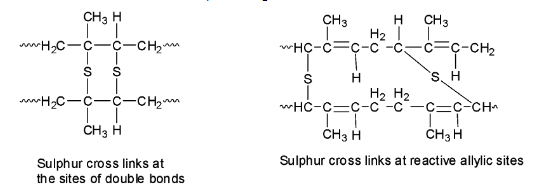
In the vulcanization of rubber:
A. Sulphur reacts to form a new compound
B. Sulphur cross-links are introduced
C. Sulphur forms a very thin protective layer over rubber
D. All of the above
Answer
133.5k+ views
Hint: Vulcanization of rubber consists of heating raw rubber with sulphur at 373 K to 415 K.
Vulcanization is done to improve the properties of natural rubber and also to remove its drawbacks.
The extent of toughness of the vulcanized rubber depends upon the amount of sulphur added during vulcanization.
Complete step by step answer:
Natural rubber is soft and tacky and this softness and tackiness becomes higher at high temperatures and brittle at low temperatures. So, rubber is usually used in the temperature range of 283 to 335 Kelvin where its elasticity is maintained.
Natural rubber also has huge water absorption capacity, low tensile strength and low resistance to abrasion. So, the process of vulcanization is done to improve these properties.
The raw rubber is heated with sulphur at 373 to 415 Kelvin. The vulcanized rubber obtained has excellent elasticity, low water absorption tendency and is also resistant to organic solvents.
During vulcanization, sulphur bridges or sulphur cross-links are introduced between the polymer chains either at their reactive allylic positions or at the sites of the double bonds. Since the process is slow, additives like zinc oxide are added to speed up the rate of vulcanization.
The sulphur cross-links make rubber harder and stronger and removes the stickiness as the individual chains can no longer slip over the other but are instead locked together in a giant size molecule because of the sulphur bridges.

So, the correct option is B.
Note:
The best-known use of vulcanized rubber is the manufacture of vehicle tyres, which are combined with carbon black as a reinforcing agent for even greater strength.
Vulcanized rubber is also used in the manufacture of rubber hoses, shoe soles, erasers etc. and also used as insulation.
Vulcanization is done to improve the properties of natural rubber and also to remove its drawbacks.
The extent of toughness of the vulcanized rubber depends upon the amount of sulphur added during vulcanization.
Complete step by step answer:
Natural rubber is soft and tacky and this softness and tackiness becomes higher at high temperatures and brittle at low temperatures. So, rubber is usually used in the temperature range of 283 to 335 Kelvin where its elasticity is maintained.
Natural rubber also has huge water absorption capacity, low tensile strength and low resistance to abrasion. So, the process of vulcanization is done to improve these properties.
The raw rubber is heated with sulphur at 373 to 415 Kelvin. The vulcanized rubber obtained has excellent elasticity, low water absorption tendency and is also resistant to organic solvents.
During vulcanization, sulphur bridges or sulphur cross-links are introduced between the polymer chains either at their reactive allylic positions or at the sites of the double bonds. Since the process is slow, additives like zinc oxide are added to speed up the rate of vulcanization.
The sulphur cross-links make rubber harder and stronger and removes the stickiness as the individual chains can no longer slip over the other but are instead locked together in a giant size molecule because of the sulphur bridges.

So, the correct option is B.
Note:
The best-known use of vulcanized rubber is the manufacture of vehicle tyres, which are combined with carbon black as a reinforcing agent for even greater strength.
Vulcanized rubber is also used in the manufacture of rubber hoses, shoe soles, erasers etc. and also used as insulation.
Recently Updated Pages
JEE Main 2025 Session 2 Form Correction (Closed) – What Can Be Edited

Sign up for JEE Main 2025 Live Classes - Vedantu

JEE Main Books 2023-24: Best JEE Main Books for Physics, Chemistry and Maths

JEE Main 2023 April 13 Shift 1 Question Paper with Answer Key

JEE Main 2023 April 11 Shift 2 Question Paper with Answer Key

JEE Main 2023 April 10 Shift 2 Question Paper with Answer Key

Trending doubts
JEE Main 2025 Session 2: Application Form (Out), Exam Dates (Released), Eligibility, & More

JEE Main 2025: Conversion of Galvanometer Into Ammeter And Voltmeter in Physics

JEE Main 2025: Derivation of Equation of Trajectory in Physics

Electric Field Due to Uniformly Charged Ring for JEE Main 2025 - Formula and Derivation

Classification of Drugs

Chlorobenzene can be prepared by reacting aniline with class 12 chemistry JEE_Main

Other Pages
NCERT Solutions for Class 12 Chemistry Chapter 6 Haloalkanes and Haloarenes

NCERT Solutions for Class 12 Chemistry Chapter 2 Electrochemistry

NCERT Solutions for Class 12 Chemistry Chapter 7 Alcohol Phenol and Ether

NCERT Solutions for Class 12 Chemistry Chapter 1 Solutions

Solutions Class 12 Notes: CBSE Chemistry Chapter 1

Electrochemistry Class 12 Notes: CBSE Chemistry Chapter 2




